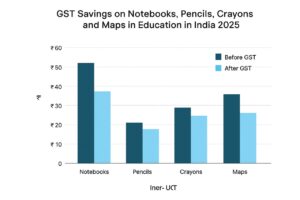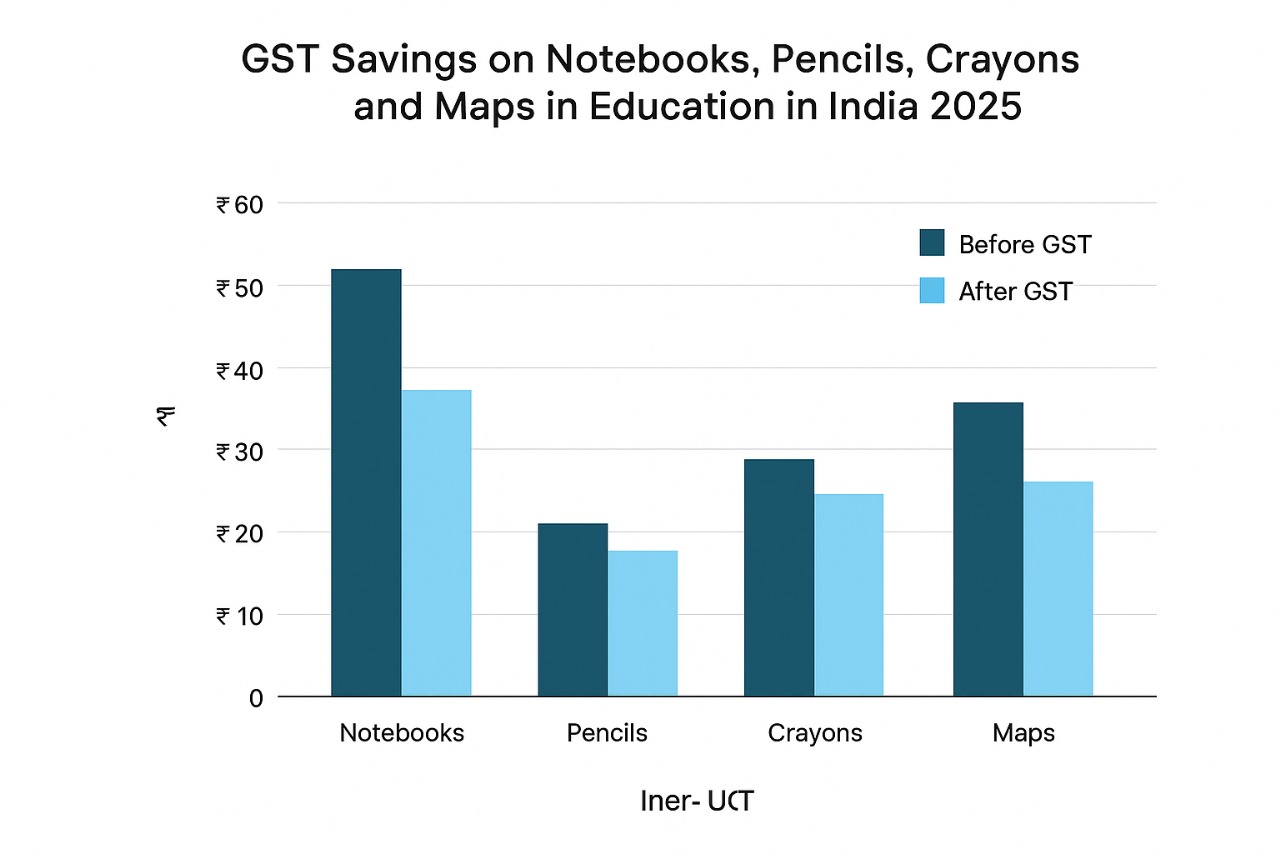📚 Education in India 2025: Tax-Free Notebooks, NIRF Rankings, Skill Education Revolution & AI Classrooms
Introduction: A Transformative Year for Education in india – 2025
Education in India 2025 marks a transformative year in the country’s learning ecosystem. From tax-free notebooks under GST reforms to NIRF Rankings 2025, skill education initiatives in Assam, and AI-powered classrooms, India’s education sector is undergoing rapid change
Education has always been at the heart of India’s development story. From the ancient Gurukul system to the modern network of IITs, IIMs, and AIIMS, India has consistently evolved its learning ecosystem to prepare future generations. In every era, education has acted as the bridge between tradition and modernity, poverty and opportunity, rural life and global ambition.
But the year 2025 stands out as a watershed moment in the history of Indian education. This year is witnessing some of the most impactful reforms and innovations in recent decades. From policy decisions that make basic learning tools more affordable, to rankings that celebrate institutional excellence, from skill-based learning initiatives in states like Assam, to the powerful integration of Artificial Intelligence in classrooms—education in India is going through a major transformation.
The purpose of this blog is to give you a comprehensive, easy-to-read, and SEO-friendly breakdown of these changes. We’ll cover:
-
The impact of tax-free notebooks and stationery under GST reforms.
-
The highlights of the NIRF Rankings 2025, showcasing India’s best colleges and universities.
-
Assam’s ambitious Hub-and-Spoke skill education model.
-
The rising role of AI in classrooms, and how it is reshaping the teacher-student relationship.
-
Broader future trends like hybrid learning, micro-credentials, mental health initiatives, and global collaborations.
By the end of this blog, you’ll have a clear picture of where Indian education is headed in 2025 and what it means for students, parents, teachers, and policymakers.
Section A: ✅ Education in India 2025: Why Tax-Free Stationery Matters
For years, Indian parents have voiced concerns over the rising costs of education. While tuition fees are the most obvious expense, hidden costs like stationery, books, and maps often pile up to become a significant burden. Imagine a family with two children in school—each year, they spend thousands of rupees on notebooks, pencils, geometry boxes, and maps. Add a 12% GST to this, and the costs only climb higher.
This is why the September 2025 GST reform was welcomed with open arms. The government announced that essential educational stationery such as notebooks, pencils, crayons, globes, and maps would now fall under the 0% GST category.
Why This Reform Matters
-
Affordability for Families
A family that used to spend ₹10,000 annually on stationery will now save around ₹1,200, thanks to the removal of GST. For middle-class and lower-income households, this is a meaningful relief. -
Promoting Equity in Education
Students in rural and semi-urban areas often drop out because of affordability issues. By making educational tools cheaper, the government has taken a step toward bridging the gap between privileged and underprivileged learners. -
Boost to Local Vendors & Publishers
Small stationery shops, publishers, and wholesalers expect demand to increase by 15–20%, as affordability improves and more parents are willing to buy extra supplies. -
Support for Government Schemes
Many state governments distribute free stationery to students. With the GST relief, the overall costs of these schemes will reduce, allowing governments to either expand coverage or allocate resources to other educational initiatives.
The Bigger Picture
This reform isn’t just about saving a few rupees. It is about sending a strong message—that education is a priority and basic learning materials should not be taxed. Countries across the world often make books and stationery tax-free, and India’s move aligns with this global standard.
Section B: NIRF Rankings 2025 and the Future of Education in India 2025
Every year, students, parents, and academic institutions eagerly await the NIRF (National Institutional Ranking Framework) Rankings. Launched in 2015 by the Ministry of Education, NIRF evaluates institutions across 17 categories based on factors like teaching, research, inclusivity, and employability outcomes.
The NIRF Rankings 2025 provide a snapshot of the best universities contributing to Education in India 2025.
Key Highlights of NIRF 2025
- These reforms highlight how affordability is shaping Education in India 2025
-
Overall Top Institution: IIT Madras has once again secured the #1 position, maintaining its reputation as a leader in engineering and interdisciplinary research.
-
Engineering: IIT Madras, IIT Delhi, and IIT Bombay claimed the top three positions.
-
Management: IIM Ahmedabad continues to dominate, followed by IIM Bangalore and IIM Calcutta.
-
Medical: AIIMS Delhi remains the undisputed #1 choice for medical aspirants.
-
Universities: IISc Bengaluru stood tall as India’s leading research-focused university.
-
Law: National Law School of India University (NLSIU), Bengaluru, retained its top spot.

Why Rankings Matter
-
For Students: With thousands of colleges to choose from, rankings act as a reliable guide. Many students use NIRF as a benchmark when applying for admissions.
-
For Institutions: Rankings create healthy competition. Colleges strive to improve research, teaching quality, and campus infrastructure to climb higher.
-
For Employers: Recruiters often prefer graduates from high-ranking institutions, linking reputation with employability.
India as a Global Education Hub
India’s higher education system is the third largest in the world, after the US and China. With NIRF rankings becoming widely recognized, they also help attract international students, who increasingly see India as a viable and affordable alternative for quality education.
Section C: Skill Education & Assam’s Hub-and-Spoke Model
India is home to the world’s largest youth population, but only a fraction of them are truly “job-ready.” According to government data, only 5% of India’s workforce has received formal vocational training, compared to over 70% in advanced economies like Germany. This glaring gap has long hindered India’s growth.
In 2025, the state of Assam took a bold step forward by introducing the Hub-and-Spoke model of skill education, in collaboration with Tata–Nelco.
Skill-based reforms like Assam’s Hub-and-Spoke model are central to Education in India 2025
What is the Hub-and-Spoke Model?
-
Hub Schools: Central institutions equipped with advanced labs, digital tools, and expert trainers.
-
Spoke Schools: Smaller government schools connected digitally to the hubs. These spoke schools receive training modules, certifications, and even live mentorship through digital channels.
Benefits of the Model
-
Digital Inclusion
Students in remote villages gain access to the same training as urban peers, reducing the rural-urban skills gap. -
Industry Alignment
Courses are designed in consultation with industry partners, ensuring that students are trained in practical, job-ready skills. -
Gender Empowerment
Special efforts are made to bring rural girls into the skill education ecosystem, offering them training in areas like digital literacy, healthcare, and entrepreneurship.
A Step Towards NEP 2020 Goals
The National Education Policy (NEP) 2020 had emphasized integrating vocational education into mainstream schooling. Assam’s initiative is one of the first large-scale, structured implementations of this vision.
Section D: AI Classrooms: Reshaping Education in India 2025
If 2020 was the year of online learning due to COVID-19, 2025 is the year of AI-driven classrooms. Artificial Intelligence is no longer just a futuristic idea; it is actively shaping the way Indian students learn and teachers teach.
How AI is Being Used
-
Personalized Learning: AI platforms analyze student performance and suggest customized learning paths.
-
Smart Assessments: Instead of one-size-fits-all tests, AI creates adaptive quizzes that challenge students at their own level.
-
24/7 Learning Support: AI chatbots help students clarify doubts at any time, reducing dependence on after-school tuitions.
-
Teacher Empowerment: AI handles repetitive tasks like grading objective tests, freeing teachers to focus on higher-order teaching.
Challenges of AI Adoption
-
Over-Reliance: Students risk becoming passive learners if they depend too much on AI for answers.
-
Ethical Concerns: Issues like plagiarism, misinformation, and data privacy remain unsolved.
-
Teacher Training: Many teachers are still learning how to effectively use AI tools in classrooms.
The Teacher’s New Role
Far from replacing teachers, AI is actually redefining their role. Teachers are now seen as mentors, facilitators, and emotional guides, while AI takes care of drills and analytics. This blend creates a balanced learning ecosystem where human intelligence and artificial intelligence complement each other.
Section E: The Future of Education in India 2025 — Key Trends
While GST reforms, NIRF rankings, Assam’s skill model, and AI classrooms are shaping 2025, the bigger picture shows even more exciting trends:
-
Hybrid & Blended Learning – A mix of online and offline teaching is here to stay, offering flexibility for students and teachers.
-
Micro-Credentials & Short Courses – More students are opting for short, skill-focused certifications alongside their degrees.
-
Mental Health Awareness – Schools and colleges are setting up counseling centers to address stress, anxiety, and peer pressure.
-
EdTech Expansion – AR/VR classrooms, gamified learning apps, and interactive simulations are gaining popularity.
-
Global Collaborations – Indian universities are signing MoUs with foreign institutions to allow student exchange and research partnerships.
Conclusion: Education in India 2025 at a Turning Point
In conclusion, Education in India 2025 is not just about exams and rankings—it is about building an inclusive, affordable, and tech-driven system. From GST reforms to AI classrooms, this year is setting the foundation for the future of Indian education.
-
The GST exemption on notebooks and stationery makes education more affordable and inclusive.
-
The NIRF Rankings 2025 showcase India’s institutional strength and global aspirations.
-
Assam’s Hub-and-Spoke skill education model is a pioneering step toward vocational readiness.
-
The integration of AI in classrooms is reshaping the roles of teachers and students alike.
But challenges remain: bridging the digital divide, ensuring equitable access, and balancing human values with technological tools.
As we step into the future, one thing is clear: education in India is no longer just about exams and degrees. It is about creating well-rounded, skilled, empathetic, and globally competent citizens.
👉 What’s your take?
-
Do GST reforms make a real difference for struggling families?
-
Should India adopt AI more aggressively in schools, or proceed with caution?
-
How can vocational training be mainstreamed further?
💡 Share your thoughts in the comments below, and subscribe to our newsletter for more deep dives into Education, Policy, and Technology in India.
visit : http://aaopadhein.org
Also Read ; Online Tuition (AaoPadhein.org) for CLAT and 7 Other Exams: The Complete Guide for Students
AaoPadhein Online Tuition: CBSE छात्रों के लिए घर बैठे पढ़ाई का स्मार्ट समाधान
